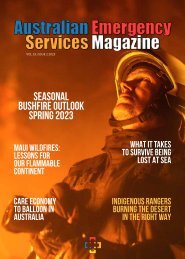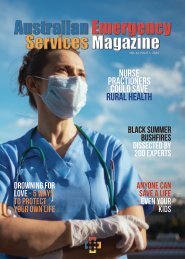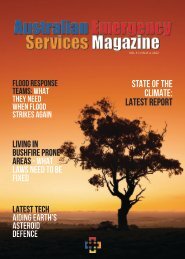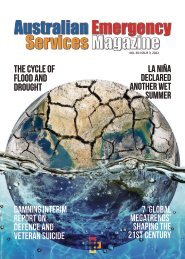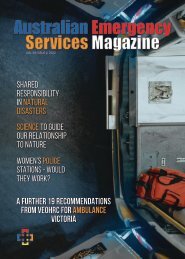Vol. 3 Issue 2. 2017
The Australian Emergency Services Magazine is a community educational resource dedicated to the recognition and promotion of emergency service personnel, and the awareness of safety measures, for the community, family and individual. We aim to provide relevant and up to date information and advancements within each of the emergency response sectors and first responders.
The Australian Emergency Services Magazine is a community educational resource dedicated to the recognition and promotion of emergency service personnel, and the awareness of safety measures, for the community, family and individual. We aim to provide relevant and up to date information and advancements within each of the emergency response sectors and first responders.
Create successful ePaper yourself
Turn your PDF publications into a flip-book with our unique Google optimized e-Paper software.
Autumn <strong>2017</strong><br />
LEST WE FORGET<br />
ANZAC DAY <strong>2017</strong><br />
25TH APRIL
22-23 MAY <strong>2017</strong> JUPITERS HOTEL GOLD COAST<br />
www.anzdmc.com.au<br />
The Australian Emergency Services Magazine<br />
and Boothbook Media proudly supports<br />
the Australian & New Zealand Disaster and<br />
Emergency Management Conference
Editor’s Note<br />
CONTENTS<br />
2<br />
Latest Events<br />
• <strong>Vol</strong>unteer Week<br />
• ANZ Emergency and<br />
Disaster conference<br />
Anzac Day - remembering our<br />
emergency services<br />
Bail reform after Bourke<br />
Street tragedy<br />
Emergency Kit Essentials<br />
Understanding thunderstorm<br />
asthma<br />
Climate change and the latest<br />
heatwaves<br />
<strong>Vol</strong>unteering - your essential<br />
guide to volunteering for<br />
emergency services<br />
The importance of social ties<br />
during disaster recovery<br />
National rollout of cyber<br />
safety program<br />
Tune into emergency<br />
warnings<br />
3<br />
5<br />
6-7<br />
8-9<br />
10-11<br />
12-15<br />
16-19<br />
20-23<br />
24-27<br />
28<br />
30<br />
australian<br />
emergency<br />
services magazine<br />
www.aesj.com.au<br />
MAGAZINE CONTACTS<br />
1300 851 710<br />
press@aesj.com.au<br />
DISCLAIMER<br />
The Australian Emergency Services Magazine is a community<br />
educational resource and does not promote itself as a charity<br />
or fund raising institution, nor solicit on behalf of charities<br />
and is no way financially supported by or associated with<br />
any government or similar institution. Distributions of the<br />
publication is Quarterly and are circulated via a database of<br />
interested parties, including business, subscribers, advertisers,<br />
volunteer emergency organistations, and council libraries.<br />
A digital eMag is distributed to a targeted database in each<br />
State & Territory. All information published in the Australian<br />
Emergency Services Magazine is in good faith and whilst every<br />
effort is made to ensure that the publication is free of error<br />
and omission, no responsibility or liability will be accepted by<br />
Boothbook Pty Ltd.<br />
Published by Boothbook Media<br />
ABN:72 605 987 031<br />
www.boothbookmedia.com.au<br />
1
EDITORS NOTE<br />
2<br />
Welcome to the Autumn Edition of<br />
the Australian Emergency Services<br />
Magazine. And what a long hot<br />
summer it was! Looking forward to<br />
the cool change that Autumn brings<br />
and an end to the notoriously busy<br />
season for our emergency service<br />
personnel.<br />
This summer season certainly<br />
had our emergency services and<br />
volunteers going the extra mile<br />
and demonstrating as always what<br />
an amazing job they do in our<br />
communities.<br />
The Bourke Street tragedy on<br />
January 20th in Melbourne shocked<br />
and saddened us all, but will forever<br />
have a place in the hearts of the<br />
residents of Melbourne, the families<br />
affected and the emergency services<br />
personnel that were first on the<br />
scene.<br />
Craig Lapsely, the Emergency<br />
Management Commisioner<br />
expressed these deep sentiments.<br />
“Our thoughts are with not only<br />
those who have lost their lives, but<br />
those who are injured physically,<br />
and those who will be scarred<br />
for such a long time by what they<br />
witnessed, what they did, how they<br />
helped. We’ve seen bravery, we’ve<br />
seen people doing their jobs and we<br />
have seen ordinary people doing<br />
extraordinary things. The impact for<br />
all of us is far reaching, including for<br />
those who are thinking “what if ”?”<br />
Bushfires, storms and floods also<br />
had their devastating affect on<br />
communities around the country<br />
with many families losing their<br />
homes to these natural disasters that<br />
seem to be more prevalent each year.<br />
This highlights the value of having<br />
strong community ties and how<br />
important it is to look after our<br />
neighbours. To celebrate this<br />
community spirit and to hopefully<br />
inspire you, this issue includes a<br />
definitive guide to volunteering in<br />
your community in the emergency<br />
services sector.<br />
On April 25th ANZAC Day services<br />
will be held around the country. We<br />
take a look back at the history of the<br />
emergency service volunteers during<br />
WW2 and the invaluable role they<br />
played around the country. Check<br />
out your local council website for<br />
ANZAC day services in your area.<br />
From all the team at the Australian<br />
Emergency Services Magazine we<br />
wish you a cooler and more peaceful<br />
Autumn.<br />
Emma Parker<br />
Editor
LATEST NEWS<br />
<strong>Vol</strong>unteer Week <strong>2017</strong><br />
8-14th may<br />
Save the date! National <strong>Vol</strong>unteer<br />
Week, 8–14 May <strong>2017</strong><br />
National <strong>Vol</strong>unteer Week<br />
(NVW) is an annual celebration<br />
to acknowledge the generous<br />
contribution of our nation’s<br />
volunteers.<br />
From 8–14 May <strong>2017</strong> thousands<br />
of events across the country will<br />
be held to say thank you to the 6<br />
million Australians who volunteer<br />
including breakfasts, morning/<br />
afternoon teas, and luncheons<br />
as well as open days, award<br />
ceremonies, picnics, forums and<br />
training sessions.<br />
‘Give Happy, Live Happy’ is the<br />
catch cry of this year’s national<br />
volunteer week and there are plenty<br />
of reasons why volunteering in<br />
your local community will not only<br />
improve the lives of those around us<br />
but also for you too!<br />
Professor Thomas Neilson from the<br />
University of Canberra advocates<br />
the benefits of volunteering in the<br />
following ways:<br />
As a healthy lifestyle choice:<br />
“One of the healthiest things we<br />
can do is to volunteer. <strong>Vol</strong>unteering<br />
leads to healthier, happier, and<br />
longer lives. Sustainable wellbeing<br />
comes not from money or<br />
consumerism, but from<br />
having meaningful happiness in our<br />
lives. Studies show intimate links<br />
between generosity and our<br />
immune systems. We now know<br />
that volunteering is not just good<br />
for our physical health, but for our<br />
psychological and emotional health<br />
too.”<br />
As a true community builder:<br />
Engaging in generous and altruistic<br />
behaviour makes you want to<br />
be more generous and altruistic.<br />
<strong>Vol</strong>unteering, health, and happiness<br />
together create a positive,<br />
reinforcing loop: the more you<br />
volunteer, the healthier you become,<br />
the more you want to volunteer.<br />
<strong>Vol</strong>unteering is a true community<br />
builder in that sense.<br />
As a predictor of health and<br />
happiness:<br />
There is one shared denominator<br />
for what people across cultures and<br />
religions report as giving them<br />
meaningful happiness in their<br />
lives: being something for others.<br />
When we give of ourselves to others<br />
through volunteering we experience<br />
an array of health benefits from<br />
hormones rushing through our<br />
biology, increasing our resistance to<br />
disease and adversity. In fact, giving<br />
is one of the strongest predictors of<br />
increasing our health and<br />
happiness.<br />
At www.volunteeringaustralia.org<br />
you can purchase lots of goodies<br />
to show your support, download<br />
resources to display in your<br />
workplace to help speread the word<br />
or register your own event.<br />
References:<br />
www.volunteeringaustralia.org/nvw<br />
Associate Professor Thomas Neilson, University of<br />
Canberra<br />
Nielsen, T. W. (2013). Meaningful Living. http://<br />
www.thomaswnielsen.net/giving-makes-us-happy/<br />
<strong>2.</strong> Thomas W. Nielsen, The Canberra Times,<br />
June 14, 2010. http://www.thomaswnielsen.net/<br />
resources/meaningful-living/<br />
3
4
LATEST NEWS<br />
DISASTER AND EMERGENCY<br />
MANAGEMENT CONFERENCE<br />
<strong>2017</strong> Australian & New<br />
Zealand Disaster & Emergency<br />
Management Conference<br />
The 6th Australian and New<br />
Zealand Disaster and Emergency<br />
Management Conference will be<br />
held from 22nd to 23rd of May, at<br />
Jupiters Hotel on the Gold Coast,<br />
Queensland.<br />
The Conference theme “EARTH;<br />
FIRE and RAIN” will continue<br />
to address planning, response<br />
and review the latest research<br />
in the management of disasters,<br />
emergencies and hazards.<br />
How do we respond to, recover<br />
from and mitigate against the<br />
impacts of disasters on our<br />
communities, emergency service<br />
personnel, infrastructure and<br />
provision of services.<br />
What can we learn from our<br />
international colleagues and the<br />
research being undertaken in<br />
Australia.<br />
The conference will address these<br />
issues and more.<br />
Join our Australian and<br />
International delegates, more<br />
than 100 speakers, our exhibitors<br />
and partners at this must attend<br />
event for people working in and<br />
with the emergency and disaster<br />
management sector.<br />
Topics discussed at the conference<br />
include:<br />
• Technology and Operations<br />
• Multi-Agency Response<br />
• Understanding and Enhancing<br />
Resilience<br />
• Emerging Technology and<br />
Capability Needs<br />
• The Recovery Process<br />
• Crisis Leadership<br />
• <strong>Vol</strong>unteers in Emergencies<br />
• Psycho-Social Implications of<br />
Disaster Management<br />
• International Response to<br />
Disasters<br />
• Consequence Management<br />
• Open Topics<br />
Confirmed Speakers:<br />
Mr Rod Young, National<br />
Emergency Response Manager,<br />
Telstra<br />
Mr John Yates QPM, Director of<br />
Security – Scentre Group, Australia<br />
and New Zealand, Westfield<br />
Corporation – US, UK & Europe<br />
Ms Judy Slatyer, CEO, Australian<br />
Red Cross<br />
Dr Susie Burke, Senior Psychologist,<br />
Public Interest, Environment and<br />
Disaster Response, Australian<br />
Psychological Society<br />
Dr Paul Barnes, Head, Risk &<br />
Resilience, Australian Strategic<br />
Policy Institute<br />
Associate Professor Peter Aitken,<br />
Senior Director, Health Disaster<br />
Management Unit, Queensland<br />
Health<br />
To reserve your place at the<br />
conference or to exhibit visit:<br />
www.anzdmc.com.au<br />
5
THIS ANZAC DAY WE<br />
REMEMBER OUR<br />
EMERGENCY SERVICE<br />
VOLUNTEERS<br />
This ANZAC Day we look back<br />
at the role the emergency services<br />
played during WW<strong>2.</strong><br />
The National Emergency Services<br />
NSW (NES) helped to protect,<br />
educate and provide aid on<br />
the home front. The NES was<br />
established in 1939 and by the<br />
end of World War II 115,418<br />
people had volunteered with the<br />
organisation.<br />
Nearly half of these volunteers<br />
were enrolled as wardens. During<br />
the War, from the Hunter to the<br />
Illawarra, there were 464 air raid<br />
sirens, 70,000 feet (21,336 m) of<br />
trench shelters, 36,000 ft (10,972<br />
m) of covered trenches and 139<br />
pillbox air raid shelters.<br />
Australian Commonwealth and<br />
State Ministers agreed in 1936,<br />
that for civil defence purposes,<br />
they would train key personnel<br />
in preparation for gas attacks,<br />
provide equipment, manuals,<br />
technical information and advice.<br />
This was the very beginning of<br />
Australia’s Civil Defence Service.<br />
During WWII, many Australians<br />
were volunteers, appointed as Air<br />
Raid Wardens by the National<br />
Emergency Services, monitoring<br />
air raid security and breaches<br />
of blackout regulations. In cities<br />
and towns around the country,<br />
evacuation procedures were<br />
planned and practised.<br />
After the war, around the late<br />
1940s, the Commonwealth<br />
reactivated the Civil Defence<br />
Service, and during the 1950s<br />
the States accepted responsibility<br />
for civil defence organisations.<br />
Each State formed a headquarters<br />
and volunteer units at local<br />
government level.<br />
6
This was the beginning of the SES<br />
that we know today.<br />
In 1942, a famous advertisement<br />
featuring the Prime Minister John<br />
Curtin called on all Australians<br />
to assist in the war effort. Men,<br />
women and children were called<br />
upon to support and protect their<br />
homes from the enemy.<br />
“What are you doing for Australia<br />
in her darkest hour?” was the<br />
slogan used.<br />
Anticipating Japanese air and<br />
submarine attacks, blackout<br />
restrictions were introduced and<br />
air raid warning instructions<br />
issued. Families dug air raid<br />
shelters in their backyards and<br />
barbed wire was strung across<br />
beaches.<br />
Many men who were unable to<br />
enlist because of their age or their<br />
essential war occupations joined<br />
home defence organisations.<br />
Members of the <strong>Vol</strong>unteer<br />
Defence Corps (VDC) and the<br />
<strong>Vol</strong>unteer Air Observers Corps<br />
(VAOC) helped to erect and patrol<br />
coastal defences or spot aircraft<br />
and shipping.<br />
Others joined the Naval Auxiliary<br />
patrol, a voluntary organisation<br />
attached to the Royal Australian<br />
Navy. Many of the volunteers<br />
provided their own vessels, from<br />
dinghies to luxury yachts, to patrol<br />
Sydney Harbour and coastal areas.<br />
The possibility of Japanese<br />
invasion prompted the Australian<br />
Government to assume<br />
extraordinary wartime emergency<br />
powers. Prime Minister John<br />
Curtin was able to invoke defence<br />
powers under the Constitution<br />
which allowed the government<br />
broad, wartime authority and<br />
which gave Curtin probably the<br />
most power of any Australian<br />
Prime Minister.<br />
A standard wooden alarm rattle<br />
was used by Air Raid and Civil<br />
Defence Wardens to warn local<br />
residents of potential air raids or<br />
gas attacks. The rattle made a very<br />
loud, sharp clacking sound that<br />
was designed to attract attention.<br />
The government also introduced<br />
strict censorship of the media.<br />
Any information that might<br />
damage public morale such<br />
as explicit details of enemy<br />
attacks, Australian losses or<br />
even unexploded bombs on<br />
Australian soil was censored by<br />
local authorities on the instruction<br />
of the Chief Publicity Censor in<br />
Canberra.<br />
To honour those men and women<br />
who bravely fought and volunteered<br />
within the community and<br />
those who are still engaged in war<br />
overseas attend a local ANZAC<br />
ceremony in your local area.<br />
Check your local council website<br />
for information or contact your<br />
local RSL club.<br />
7
Victoria should not rush in on<br />
bail reform<br />
The horrifying event in Melbourne’s<br />
CBD on the 20th January was yet<br />
another episode where a person<br />
used a vehicle as a weapon of<br />
destruction. It left five people,<br />
including a baby boy, dead. Another<br />
30 people were injured, many<br />
seriously.<br />
The alleged perpetrator, Dimitrious<br />
Gargasoulas, was revealed to be on<br />
bail in relation to another alleged<br />
offence six days before the attack,<br />
despite opposition from Victoria<br />
Police prosecutors. A bail justice (an<br />
out-of-hours volunteer honorary<br />
justice, like a justice of the peace)<br />
had granted Gargasoulas bail on<br />
January 14.<br />
In response, Victorian Premier<br />
Daniel Andrews has announced<br />
that magistrates, rather than bail<br />
justices, will be exclusively deployed<br />
to hear bail applications in serious<br />
matters. Andrews has also directed<br />
the former director of public<br />
prosecutions, Paul Coghlan, to<br />
review Victoria’s bail system.<br />
Does the bail justice system work?<br />
Faced with cries to “do something”<br />
when a crisis erupts, governments,<br />
understandably, become risk-averse.<br />
So, it was quite predictable that the<br />
Andrews government’s first target in<br />
this case was the bail justice system.<br />
This uniquely Victorian initiative<br />
has drawn praise for more than two<br />
decades.<br />
While one can sympathise with<br />
those who are calling for review and<br />
change, we need to exercise caution<br />
before overhauling the operation of<br />
bail laws on the basis of one, albeit<br />
horrendous and tragic, case.<br />
The bail justice system is one of the<br />
reasons usually given to explain<br />
why Victorians continue to enjoy<br />
the lowest remand-in-custody rates<br />
in Australia.<br />
There is no evidence that that<br />
achievement has compromised<br />
safety for Victorians generally.<br />
Moreover, police officers actually<br />
make 90% of bail decisions;<br />
magistrates or bail justices are only<br />
called in to adjudicate in the event<br />
of police denying bail.<br />
8
There is also no reason to suspect<br />
that a magistrate would not have<br />
reached the same bail conclusion<br />
as the bail justice did in relation to<br />
Gargasoulas on January 14.<br />
Denying bail fills our prisons<br />
The denial of bail is also a<br />
significant factor in the seemingly<br />
unstoppable rise in Australia’s<br />
prisoner numbers.<br />
There was yet another significant<br />
rise in numbers last year. In the<br />
September quarter of 2016, the<br />
average number of full-time<br />
prisoners was 38,998. Of these, 32%<br />
(12,332) were unsentenced – that is,<br />
denied bail.<br />
This takes Australia, for the first<br />
time in its modern history, out<br />
of the 15-30% range – which<br />
includes, for example, the UK, the<br />
US, Canada, Russia, Israel, Poland,<br />
New Zealand and Germany – and<br />
puts it into the 30-50% range found<br />
in Brazil, Thailand, Papua New<br />
Guinea, France, Kenya and Mexico.<br />
The number of unsentenced<br />
prisoners in Australia increased<br />
by 22% from 2015 to 2016. This<br />
followed a 21% increase from 2014<br />
to 2015. Over the last five years,<br />
unsentenced prisoner numbers in<br />
Australia have increased 81%. The<br />
trend is financially and socially<br />
irresponsible and unsustainable.<br />
Australians need to be a little more<br />
forgiving regarding the decisions of<br />
bail authorities when their decisions<br />
turn out to be ill-fated. Thousands<br />
of accused persons are granted bail<br />
each year over police objections<br />
with few adverse consequences.<br />
Australia needs to be very<br />
careful not to allow the bail<br />
system – whether it is overseen<br />
by magistrates or lay justices – to<br />
become a political scapegoat at the<br />
hands of commentators exercising<br />
20/20 hindsight.<br />
Finally, we must be very careful not<br />
to rush to judgement and pretend<br />
that by tightening certain justice<br />
processes the problem will go<br />
away. Simply putting (and keeping)<br />
behind bars for months at a time<br />
everyone whom someone has<br />
deemed to be a risk to their family’s<br />
safety, their own safety or public<br />
safety is not the answer.<br />
This article has been amended to display<br />
the date the incident occured.<br />
First published on The Conversation<br />
Rick Sarre<br />
University of South Australia<br />
www.msccruises.com.au<br />
Meditteranean<br />
Northern Europe<br />
Caribbean<br />
South America<br />
South Africa<br />
Dubai, Abu Dhabi<br />
MSC Grand Voyages<br />
FLY, LAND & CRUISE<br />
1300 028 502<br />
DEALS BY DESTINATION<br />
CHILDREN CRUISE FREE<br />
Suite 532, 5 Lime Street King Street Wharf SYDNEY<br />
9
EMERGENCY KIT<br />
ESSENTIALS<br />
HAVING AN EMERGENCY KIT IS AN IMPORTANT STEP TO<br />
PREPARE FOR, SURVIVE AND COPE WITH EMERGENCIES.<br />
Know<br />
All householders need to<br />
know where your<br />
Emergency Kit is kept.<br />
On this page is a list of items which should be in your<br />
kit at all times. There is also a list of extra items which<br />
if you do not keep at all times you should add to your<br />
kit during storm or cyclone season.<br />
FOOD AND WATER<br />
COMMUNICATIONS<br />
Check<br />
and update the contents<br />
of your kit regularly, to<br />
ensure everything is in<br />
working order and has<br />
not expired.<br />
Discuss<br />
your Emergency Kit<br />
with all householders<br />
and make sure everyone<br />
knows what to do in an<br />
emergency.<br />
KNOW YOUR<br />
EMERGENCY<br />
CONTACTS<br />
Range of non-perishable<br />
MEDICAL AND<br />
SANITATION<br />
food items<br />
Bottled water<br />
First Aid Kit and manual<br />
Essential medications,<br />
prescriptions and dosage<br />
Toilet paper<br />
Toothbrush/toothpaste<br />
Soap/shampoo<br />
Personal hygiene items<br />
LIGHT<br />
Flashlight/torch with<br />
extra batteries<br />
Battery powered lantern<br />
Battery powered radio with<br />
extra batteries<br />
Traditional wired telephone<br />
Prepaid wired telephone<br />
Prepaid phone cards and<br />
coins for phone calls<br />
CLOTHING AND<br />
FOOTWEAR<br />
Warm jumper, waterproof<br />
jacket, hat and gloves<br />
for everyone<br />
Closed-toed shoes or<br />
boots for everyone<br />
TOOLS AND SUPPLIES<br />
Whistle, utility knife,<br />
duct/masking tape<br />
10
Plastic garbage bags, ties<br />
Safety glasses and sun glasses.<br />
MISCELLANEOUS<br />
Special items for infants<br />
(nappies, formula etc)<br />
Special items needed by<br />
elderly or people with<br />
special needs<br />
Spare house and car keys<br />
Pet food, water and<br />
other animal needs<br />
IMPORTANT DOCUMENTS<br />
Keep original or certified copies of<br />
these documents in your Emergency<br />
Kit.<br />
Scan copies of them and save the<br />
files on a USB memory stick or CD<br />
to include in your kit. Keep all these<br />
items in sealed plastic bags.<br />
Insurance papers for your<br />
house and contents, cars<br />
and for valuable items<br />
Inventory of valuable<br />
household goods<br />
Wills and life insurance documents<br />
House deeds/mortgage documents<br />
Birth and marriage certificates<br />
Passports/visa details<br />
Stocks and bonds<br />
Medicare, pension cards,<br />
immunisation records<br />
Bank account and credit card details<br />
A back-up copy of important<br />
computer files<br />
Household Emergency Plan with<br />
emergency contact numbers<br />
FOR MORE INFORMATION AND TO DOWNLOAD AN<br />
EMERGENCY PLAN FOR YOUR HOUSEHOLD GO TO:<br />
www.qld.gov.au/emergency/dealing-disasters/emergency-kit<br />
11
UNDERSTANDING<br />
THUNDERSTORM<br />
ASTHMA<br />
12<br />
On the 21st and 22nd of November<br />
2016, thousands of Victorians were<br />
affected by a thunderstorm asthma<br />
event which sadly contributed to the<br />
death of nine people.<br />
The rapid onset of this emergency<br />
and the scale of its consequences<br />
were unprecedented. The event tested<br />
the ability of Victoria’s emergency<br />
management system to consider and<br />
respond to Class 2 emergency health<br />
consequences arising from a Class 1<br />
emergency – in this case, a storm.<br />
Never before have the Emergency<br />
Services Telecommunications<br />
Authority, Ambulance Victoria or<br />
Victorian hospitals experienced this<br />
level of demand in such a condensed<br />
time period and dispersed over such<br />
a large geographical area.<br />
As a result a review was conducted<br />
into how this emergency was<br />
managed in order to better help the<br />
community and improve services and<br />
outcomes for all.<br />
Understanding what thunderstorm<br />
asthma is, how to manage it and<br />
what to do during such an event is<br />
a key to better management. One<br />
of the first outcomes of the review<br />
was that thunderstorm asthma is not<br />
well understood and neither is the<br />
ability to predict when such a storm<br />
will contain the right factors that will<br />
affect people in an adverse manner.
The thunderstorm asthma event<br />
of 21–22 November 2016 had<br />
consequences that were not typical of<br />
a thunderstorm.<br />
The unique characteristics that<br />
differed from the more commonly<br />
occurring emergencies such as<br />
bushfire, flood and thunderstorm<br />
included:<br />
• being largely invisible<br />
• being geographically dispersed<br />
and widespread<br />
• having a rapid onset<br />
• being unfamiliar or unknown,<br />
with less practiced response<br />
protocols.<br />
Allergy, asthma and allergic rhinitis<br />
(AR) are different conditions that<br />
often co-occur, and research is<br />
ongoing to fully understand the<br />
immune system interaction with<br />
allergens.<br />
In simple terms, allergies result from<br />
hyper-sensitivity to an allergen (for<br />
example dust, pollen, mould) whereas<br />
AR is associated with inflammation<br />
of the nose in response to an allergen.<br />
Asthma on the other hand is a<br />
chronic inflammatory condition<br />
located in the lower airways. There<br />
are several types of asthma, among<br />
which allergic asthma is the most<br />
common.<br />
Notwithstanding the rarer occurrence<br />
of epidemic thunderstorm asthma,<br />
as occurred in Melbourne on a much<br />
smaller scale in 2010, many people<br />
with asthma are regularly affected<br />
by the combination of elevated<br />
pollens and thunderstorms. The<br />
numbers of people affected, and the<br />
severity of their asthma are not well<br />
documented.<br />
Although there are uncertainties<br />
about the specific mechanisms<br />
involved, thunderstorm asthma<br />
is likely triggered by small sized<br />
airborne allergens, such as those from<br />
pollen and mould spores that are<br />
carried by thunderstorm downdrafts<br />
and outflows and then inhaled by<br />
allergen-sensitive individuals.<br />
Some of these small-sized allergens<br />
are caused by rupturing pollen grains<br />
as a result of climatic conditions<br />
associated with the storm activity.<br />
There are four proposed conditions<br />
for a thunderstorm asthma epidemic:<br />
• high concentrations of allergenic<br />
material (for example grass<br />
pollen or fungi)<br />
• thunderstorm outflow that<br />
sweeps up bio-aerosols and<br />
suspends them near ground level<br />
in population centres<br />
• formation of respirable-sized<br />
particles (
One example of how thunderstorm<br />
asthma occurs and affects those with<br />
respiratory conditions is outlined in<br />
the figure above.<br />
Thunderstorm asthma epidemics<br />
occur when allergen- sensitive<br />
individuals inhale air that is carrying<br />
a high concentration of airborne<br />
allergens. Notably, not all asthmatics<br />
are affected by thunderstorm asthma,<br />
and many people affected do not have<br />
a known history of asthma17.<br />
Where allergy testing of<br />
thunderstorm asthma subjects has<br />
occurred, many have had hypersensitivity<br />
to certain types of fungi<br />
and/or pollen18 19. In addition,<br />
many thunderstorm asthma subjects<br />
have reported a history of hay fever,<br />
but not asthma20 21 2<strong>2.</strong><br />
It is hypothesised that sensitive<br />
individuals are ‘primed’ by<br />
environmental factors prior to the<br />
thunderstorm so that their airways<br />
are already hyper-responsive, and<br />
that this causes the acute and severe<br />
reaction to the amount of allergens<br />
carried by the thunderstorm23 24.<br />
A potentially key priming factor is<br />
exposure to airborne allergens such<br />
as pollen or fungal spores prior to the<br />
thunderstorm.<br />
Other priming factors that may<br />
be relevant include exposure to<br />
air pollution, viral infections<br />
(particularly respiratory)25 26 and<br />
weather factors that are known to<br />
affect asthmatics more generally, such<br />
as sudden temperature changes and<br />
high humidity27.<br />
Thunderstorm asthma is a significant<br />
public health issue because of its<br />
potential to affect large numbers<br />
of people (including those with no<br />
known history of asthma), and to<br />
overwhelm emergency department<br />
(ED) resources and pharmaceutical<br />
suppliers. The most severe impact of<br />
thunderstorm asthma is the sudden<br />
MAJOR AUSTRALIAN OPERATOR OF PASSENGER LAND TRANSPORT<br />
PLAN YOUR JOURNEY AND VIEW TIMETABLE<br />
INFORMATION<br />
www.cdcbus.com.au<br />
HILLSBUS<br />
QCITY<br />
HUNTER VALLEY<br />
CDC VICTORIA<br />
SCHOOL SERVICES<br />
CHARTER SERVICES<br />
29 FOUNDRY ROAD SEVEN HILLS NSW CUSTOMERSERVICE@CDCBUS.COM.AU 02 9890 0000<br />
14
increase in asthma cases to the<br />
point of an epidemic. This includes<br />
general practitioner (GP) visits, ED<br />
presentations, and in extreme severe<br />
acute cases, hospital admissions.<br />
PREDICTING THUNDERSTORM<br />
ASTHMA<br />
Thunderstorm asthma involves<br />
interactions between meteorological<br />
factors, airborne allergens, and<br />
human factors, therefore prediction<br />
is complex. Four conditions must be<br />
considered in order to understand the<br />
potential for thunderstorm asthma<br />
prediction.<br />
1. High concentrations of alergenic<br />
material.<br />
<strong>2.</strong> Thunderstorm outflows<br />
3. Respirable-sized aeroallergens.<br />
4. Exposure of sensitive people.<br />
Factors that appear important for<br />
predicting thunderstorm asthma<br />
include:<br />
• seasonal factors: rainfall during<br />
winter, pollen season (start, peak,<br />
and end)<br />
• in the preceding days:<br />
temperature, humidity, pollen<br />
count, fungal spore count<br />
• on the day: temperature,<br />
humidity, wind direction, wind<br />
speed, pollen forecast<br />
• about the thunderstorm:<br />
thunderstorm type, direction of<br />
movement, wind speed<br />
• exposure: time of day, location of<br />
the gust front.<br />
It is important to note that there are<br />
likely other variables involved and<br />
that thresholds and triggers (for<br />
example required pollen count) are<br />
unknown.<br />
WHAT TO DO<br />
• If you already have asthma<br />
discuss an action plan with your<br />
GP during pollen season<br />
• Dont ignore symptoms of asthma<br />
even if you have never had it<br />
before.<br />
• Be aware of when thunderstoms<br />
are forecast<br />
• Stay indoors and close all<br />
windows and doors until the<br />
storm has passed.<br />
• If your condition worsens contact<br />
000 immediately<br />
You can stay informed of pollen<br />
forecast through this website<br />
provided by Deakin University:<br />
www.deakin.edu.au/students/<br />
faculties/sebe/les-students/airwatch<br />
Keep informed of weather forecasts<br />
through BOM and stay tuned to all<br />
radio and tv broadcasts.<br />
www.bom.gov.au<br />
Australian Emergency Service Magazine with<br />
reference to:<br />
© State of Victoria <strong>2017</strong><br />
Review of response to thunderstorm asthma<br />
Australia Ltd<br />
www.imcdgroup.com<br />
Detergents Pharmaceuticals Personal Care<br />
IMCD is a global leader in the sales, marketing<br />
and distribution of speciality chemicals and food<br />
ingredients. Through our technical, marketing<br />
and supply chain expertise we bring added<br />
value and growth to both our customers and<br />
principal partners throughout the world.<br />
Coatings<br />
Home care, industrial<br />
care and institutional care<br />
Pharmaceutical synthesis, innovative (brand)<br />
pharmaceuticals, generic pharmaceuticals,<br />
neutraceuticals or food supplements, veterinary<br />
Colour cosmetics, dental, deodorants,<br />
fragrances, hair care, skin care and toiletries<br />
Adhesives, construction inks,<br />
industrial coatings, paints<br />
Food & Nutrition<br />
Lubricants<br />
Synthesis<br />
Plastics<br />
Bakery, beverages, confectionary,<br />
dairy, edible oils & fats, nutrition,<br />
savoury, animal nutrition<br />
Automotive, industrial,<br />
fuel & refinery<br />
Resins, polymers, esters, plasticisers,<br />
pigments & dyes, surfactants,<br />
floculants, various additives<br />
Compounders, converters, rubbers,<br />
polyurethanes and composites<br />
IMCD Australia firmly believes in offering innovative solutions that meet sustainable demands as well as making a positive contribution to its local communities.<br />
Block 6/113 Unwin Street ROSEHILL NSW 2142 02 9897 6100<br />
15
CLIMATE CHANGE<br />
AFFECTING OUR<br />
WEATHER<br />
Climate change doubled the likelihood of the New South Wales heatwave<br />
16<br />
The heatwave that engulfed<br />
southeastern Australia at the end<br />
of last week has seen heat records<br />
continue to tumble like Jenga blocks.<br />
On Saturday February 11, as New<br />
South Wales suffered through the<br />
heatwave’s peak, temperatures soared<br />
to 47° in Richmond, 50km northwest<br />
of Sydney, while 87 fires raged across<br />
the state amid catastrophic fire<br />
conditions.<br />
On that day, most of NSW<br />
experienced temperatures at least<br />
12° above normal for this time of<br />
year. In White Cliffs, the overnight<br />
minimum was 34.2°, a new record for<br />
the state’s highest observed minimum<br />
temperature.<br />
On Friday, the average maximum<br />
temperature right across NSW hit<br />
4<strong>2.</strong>4°, beating the previous February<br />
record of 4<strong>2.</strong>0°. The new record<br />
stood for all of 24 hours before it was<br />
smashed again on Saturday, as the<br />
whole state averaged 44.0° at its peak.<br />
At this time, NSW was the hottest<br />
place on Earth.<br />
A degree or two here or there<br />
might not sound like much, but<br />
to put it in cricketing parlance,<br />
those temperature records are the<br />
equivalent of a modern test batsman<br />
retiring with an average of over 100 –<br />
the feat of outdoing Don Bradman’s<br />
fabled 99.94 would undoubtedly be<br />
front-page news.<br />
And still the records continue to fall.<br />
Mungindi, on the border of NSW and<br />
Queensland, broke the Australian<br />
record of 50 days in a row above<br />
35°, set just four years ago at Bourke<br />
Airport, with the new record now at<br />
52 days.<br />
Meanwhile, two days after that<br />
sweltering Saturday we woke to find<br />
the fires ignited during the heatwave<br />
still cutting a swathe of destruction,<br />
with the small town of Uarbry, east<br />
of Dunedoo, all but burned to the<br />
ground.<br />
This is all the more noteworthy when<br />
we consider that the El Niño of 2015-<br />
16 is long gone and the conditions<br />
that ordinarily influence our weather<br />
are firmly in neutral. This means we<br />
should expect average, not sweltering,<br />
temperatures.<br />
Since Christmas, much of eastern<br />
Australia has been in a flux of<br />
extreme temperatures. This increased<br />
frequency of heatwaves shows a<br />
strong trend in observations, which<br />
is set to continue as the human<br />
influence on the climate deepens.
It is all part of a rapid warming<br />
trend that over the past decade has<br />
seen new heat records in Australia<br />
outnumber new cold records by 12<br />
to 1.<br />
Let’s be clear, this is not natural.<br />
Climate scientists have long been<br />
saying that we would feel the<br />
impacts of human-caused climate<br />
change in heat records first, before<br />
noticing the upward swing in average<br />
temperatures (although that is<br />
happening too). This heatwave is<br />
simply the latest example.<br />
What’s more, in just a few decades’<br />
time, summer conditions like these<br />
will be felt across the whole country<br />
regularly.<br />
ATTRIBUTING THE HEAT<br />
The useful thing scientifically about<br />
heatwaves is that we can estimate<br />
the role that climate change plays<br />
in these individual events. This is a<br />
relatively new field known as “event<br />
attribution”, which has grown and<br />
improved significantly over the past<br />
decade.<br />
Using the Weather@Home climate<br />
model, we looked at the role of<br />
human-induced climate change in<br />
this latest heatwave, as we have for<br />
other events before.<br />
We compared the likelihood of such<br />
a heatwave in model simulations<br />
that factor in human greenhouse<br />
gas emissions, compared with<br />
simulations in which there is no<br />
such human influence. Since <strong>2017</strong><br />
has only just begun, we used model<br />
runs representing 2014, which was<br />
similarly an El Niño-neutral year,<br />
while also experiencing similar levels<br />
of human influence on the climate.<br />
Based on this analysis, we found that<br />
heatwaves at least as hot as this one<br />
are now twice as likely to occur. In<br />
the current climate, a heatwave of<br />
this severity and extent occurs, on<br />
average, once every 120 years, so is<br />
still quite rare. However, without<br />
human-induced climate change, this<br />
heatwave would only occur once<br />
every 240 years.<br />
In other words, the waiting time for<br />
the recent east Australian heatwave<br />
has halved. As climate change<br />
worsens in the coming decades, the<br />
waiting time will reduce even further.<br />
Our results show very clearly the<br />
influence of climate change on this<br />
heatwave event. They tell us that<br />
what we saw last weekend is a taste<br />
of what our future will bring, unless<br />
humans can rapidly and deeply cut<br />
our greenhouse emissions.<br />
Our increasingly fragile electricity<br />
networks will struggle to cope, as<br />
the threat of rolling blackouts across<br />
NSW showed. It is worth noting that<br />
the large number of rooftop solar<br />
panels in NSW may have helped to<br />
avert such a crisis this time around.<br />
Our hospital emergency departments<br />
also feel the added stress of heat<br />
waves. When an estimated 374<br />
people died from the heatwave that<br />
preceded the Black Saturday bushfires<br />
the Victorian Institute of Forensic<br />
Medicine resorted to storing bodies<br />
in hospitals, universities and funeral<br />
parlours. The Victorian heatwave of<br />
January 2014 saw 167 more deaths<br />
than expected, along with significant<br />
increases in emergency department<br />
presentations and ambulance callouts.<br />
Infrastructure breaks down during<br />
heatwaves, as we saw in 2009 when<br />
railway lines buckled under the<br />
Maximum temperature anomalies across NSW on February 11, the peak of the heatwave. Bureau of<br />
Meteorology, Author provided<br />
17
extreme conditions, stranding<br />
thousands of commuters. It can also<br />
strain Australia’s beloved sporting<br />
events, as the 2014 Australian Open<br />
showed.<br />
These impacts have led state<br />
governments and other bodies to<br />
investigate heatwave management<br />
strategies, while our colleagues at<br />
the Bureau of Meteorology have<br />
developed a heatwave forecast service<br />
for Australia.<br />
These are likely to be just the<br />
beginning of strategies needed to<br />
combat heatwaves, with conditions<br />
currently regarded as extreme set to<br />
be the “new normal” by the 2030s.<br />
With the ramifications of extreme<br />
weather clear to everyone who<br />
experienced this heatwave, there is no<br />
better time to talk about how we can<br />
ready ourselves.<br />
We urgently need to discuss the<br />
health and economic impacts of<br />
heatwaves, and how we are going to<br />
cope with more of them in the future.<br />
We would like to acknowledge<br />
Robert Smalley, Andrew Watkins<br />
and Karl Braganza of the Australian<br />
Bureau of Meteorology for providing<br />
observations included in this<br />
article. This article was amended on<br />
February 16, <strong>2017</strong>, to include updated<br />
weather observations.<br />
This article was first published on ‘The<br />
Conversation’<br />
Sarah Perkins-Kirkpatrick<br />
Research Fellow UNSW<br />
Andrew King<br />
Climate Extremes Research Fellow<br />
University of Melbourne<br />
Matthew Hale<br />
Research Assistant UNSW<br />
18
INTENTION COMMITMENT DELIVER<br />
SouthEast Qld Commercial Formwork Company<br />
with over 25yrs in the industry<br />
www.infinityconstructionsqld.com.au<br />
07 3287 2724<br />
info@infinityconstructionsqld.com.au<br />
3/191 Sandy Creek Road YATALA QLD<br />
www.bullfrogs.com<br />
FURNITURE STATUES OTHER DECOR<br />
Stunning modern &<br />
classic Balinese<br />
furniture<br />
Various types of<br />
statues from the<br />
popular to the rare<br />
Be inspired by our<br />
broad collection of<br />
Balinese home decor<br />
“Bring the Resort Look at Home”<br />
Balinese Decor and Furniture Mornington Peninsula<br />
03 5973 6308 0400 025 828<br />
Visit our showroom at:<br />
Factory 3 1 Watt Road<br />
MORNINGTON VIC<br />
simon.kennedy3@bigpond.com<br />
www.sealy.com.au<br />
Over 75 years of setting the standard in quality bedding<br />
MANUFACTURER<br />
1299 BOUNDARY ROAD WACOL QLD<br />
07 33315200 gbatchelor@sealy.com.au<br />
19
In support of national<br />
volunteer week we look at<br />
ways you can volunteer in<br />
your local community and why<br />
volunteering is so rewarding<br />
In recognition of National <strong>Vol</strong>unteer<br />
Week this year on the 8th-14th<br />
May, we thought we would take<br />
the moment to discuss why<br />
volunteering is so important in the<br />
community and different ways you<br />
can get involved.<br />
There is obviously many ways you<br />
can volunteer within your local<br />
community, depending on what<br />
your passion is. Here at Australian<br />
Emergency Services Magazine<br />
we obviously have a passion for<br />
our volunteers who work in the<br />
emergency sector. There are many<br />
roles within this sector to suit a<br />
wide range of people.<br />
Your local council and state<br />
government websites contain lots<br />
of information about these different<br />
roles and how to apply.<br />
Rather than spending time surfing<br />
the net we have brought you all the<br />
latest information state to state and<br />
links to get in contact with these<br />
organisations.<br />
If you want to volunteer but are not<br />
sure where to start here are some<br />
broad suggestions:<br />
Go<strong>Vol</strong>unteer is an online tool that<br />
enables you to search different<br />
positions across the country. You<br />
can search by organisation, position<br />
or post code.<br />
www.govolunteer.com.au<br />
Contact your local volunteering<br />
centre<br />
These services offer you the<br />
opportunity to make an<br />
appointment and talk to somebody<br />
about volunteering and the<br />
opportunities available to meet your<br />
requirements.<br />
Contact your local council<br />
Many municipal and shire councils<br />
• Produce community directories<br />
that include not-for-profit<br />
organisations needing volunteers, or<br />
• Include lists of volunteering<br />
opportunities on their website, or<br />
• You could get in touch with the<br />
community services department<br />
in the council, as these people<br />
may have knowledge of local<br />
opportunities.<br />
Look at your local newspaper<br />
Often there are articles about<br />
volunteering and community<br />
service advertisements that inform<br />
people about local volunteering<br />
roles.<br />
20
Contact your local neighbourhood<br />
house or community centre<br />
Ask for information about their<br />
volunteering opportunities or<br />
information about other volunteer<br />
involving organisations in the area.<br />
Interested in a specific cause?<br />
You might like to search on the<br />
internet for organisations that<br />
address or respond to issues related<br />
to that cause. You might also like<br />
to ask at your local library for<br />
information on groups that try<br />
to effect change in society such<br />
as advocacy, human rights or the<br />
environment.<br />
Interested in volunteering in a<br />
specific sector?<br />
If you have decided on the sector<br />
where you might like to volunteer,<br />
you could consider the following<br />
options:<br />
• Health: You might like to phone<br />
a local hospital or community<br />
health service and ask about their<br />
volunteering opportunities.<br />
• Education: Enquire at schools and<br />
other education institutions.<br />
• Environment: Enquire at<br />
your local council and other<br />
environmental organisations both<br />
locally and nationally.<br />
• Sport and recreation: Contact<br />
your local council for information<br />
on sporting clubs and groups, or<br />
visit the websites of state bodies for<br />
particular sports.<br />
• Arts/culture: Enquire at local<br />
museums, libraries and not-forprofit<br />
galleries and heritage centres.<br />
• Emergency: Using either the<br />
phone book or website look for<br />
volunteer based fire, emergency,<br />
surf life saving, first aid, ambulance<br />
or coast guard/patrol groups.<br />
• Business/professional/union:<br />
Contact your local chamber of<br />
commerce or a professional body<br />
or union you belong to or are<br />
interested in supporting.<br />
• Law/justice/political: Enquire at<br />
the head office in your state for the<br />
contact details of local branches or<br />
political parties.<br />
Another option would be to<br />
contact the Department of Justice<br />
in your state for information about<br />
volunteer programs that support<br />
people dealing with the justice<br />
system.<br />
21
Emergency Service <strong>Vol</strong>unteering<br />
State by State:<br />
STATE EMERGENCY SERVICE<br />
The State Emergency Service (SES)<br />
is a volunteer-based organisation<br />
empowering people to help<br />
themselves and others in times of<br />
emergency and disaster.<br />
The SES responds at local and<br />
national levels in disasters and<br />
emergencies, and is the primary<br />
response agency for storms and<br />
floods.<br />
SES volunteers are ‘ordinary<br />
people doing extraordinary things’.<br />
<strong>Vol</strong>unteering with the SES is a<br />
challenging and rewarding way to<br />
give back to your community.<br />
Queensland SES<br />
New South Wales SES<br />
ACT SES<br />
Victorian SES<br />
South Australia SES<br />
Tasmania SES<br />
Western Australia SES<br />
Northern Territory ES<br />
RURAL FIRE SERVICE<br />
The Rural Fire Service (RFS) needs<br />
all types of people, with a wide<br />
range of skills, to keep brigades<br />
running and communities safe. The<br />
purpose of rural fire brigades is to<br />
operate in areas not covered by State<br />
and Territory Fire and Emergency<br />
Services urban (town) services.<br />
Queensland RFS<br />
New South Wales RFS<br />
ACT RFS<br />
Victoria CFA<br />
South Australia CFS<br />
Tasmania TFS<br />
Western Australia BFS<br />
Northern Territory FES<br />
AMBULANCE SERVICE<br />
There are many ways volunteers<br />
can assist in the ambulance service.<br />
In some states volunteers are<br />
trained and acredited and also have<br />
volunteers who are considered first<br />
responders before the ambulance<br />
service arrives. These services are<br />
particularly important in rural<br />
areas where services are limited and<br />
distances are great.<br />
QLD Ambulance Service<br />
NSW Ambulance Service<br />
ACT St John Ambulance Service<br />
Victorian Ambulance Service<br />
South Australian Ambulance<br />
Service<br />
Tasmania Ambulance Service<br />
Western Australian St John<br />
Ambulance Service<br />
Northern Territory St John<br />
Ambulance Service<br />
COMMUNITY RESPONSE TO<br />
EXTREME WEATHER (CREW)<br />
Join the Emergency <strong>Vol</strong>unteering<br />
CREW, where you can volunteer to<br />
INTERPRET PLUMBING<br />
PLUMBING DESIGN & CONSULTING NEW RESIDENTIAL PLUMBING PLUMBING RENOVATIONS LIGHT COMMERCIAL & INDUSTRIAL<br />
Sewer and stormwater drainage<br />
Detailed trenching and boring<br />
Septic and waste water systems<br />
Fresh water supply connections and reticulation<br />
Rainwater tanks & pumps<br />
Hot water systems including solar hot water systems and heat pump systems<br />
Underfloor heating<br />
General/ongoing plumbing maintenance including resolving blocked drains and CCTV drain inspections<br />
WE OFFER A WIDE RANGE OF PLUMBING SERVICES<br />
www.interpretplumbing.com.au<br />
PTY LTD<br />
chris@interpretplumbing.com.au<br />
0434 541 290 121 THE AVENUE, GRANVILLE NSW<br />
22
help your community in disasters<br />
and emergencies.<br />
<strong>Vol</strong>unteers lend a hand – when<br />
it’s safe to do so, before and after<br />
disasters – with preventative<br />
measures, immediate clean-up and<br />
large-scale, long-term recovery<br />
projects.<br />
The difference that you can make<br />
to a disaster-affected family,<br />
community group or organisation is<br />
immeasurable.<br />
<strong>Vol</strong>unteering Australia CREW<br />
COMMUNITY ORGANISATIONS<br />
Each state will have its own<br />
particular organisations that you<br />
can volunteer in. Visit your local<br />
government or state website for<br />
further details. However we have<br />
compiled a list of the major ones<br />
that you should be able to find<br />
nationally.<br />
Australian <strong>Vol</strong>unteer Coast Guard<br />
Surf Life Saving<br />
<strong>Vol</strong>unteering Australia<br />
Australian Red Cross<br />
Lifeline<br />
Salvation Army<br />
St Vincent de Paul Society<br />
References:<br />
volunteeringaustralia.org<br />
Queensland & NSW Government<br />
PREMIUM QUALITY<br />
AUTO GLASS SERVICE<br />
WINDSCREEN REPLACEMENT<br />
CHIP REPAIR<br />
RESEAL<br />
HOME OR WORKPLACE<br />
‘If it moves and has glass we can fix it!’<br />
michael@mjrautoglass.com.au<br />
www.mjrautoglass.epage.at/<br />
PO BOX 8098 GUNDAROO NSW 2620<br />
23
Recovering from disasters: Social networks<br />
matter more than bottled water and<br />
batteries<br />
24<br />
Standard advice about preparing<br />
for disasters focuses on building<br />
shelters and stockpiling things<br />
like food, water and batteries.<br />
But resilience - the ability to<br />
recover from shocks, including<br />
natural disasters - comes from our<br />
connections to others, and not from<br />
physical infrastructure or disaster<br />
kits.<br />
Almost six years ago, Japan faced a<br />
paralyzing triple disaster: a massive<br />
earthquake, tsunami, and nuclear<br />
meltdowns that forced 470,000<br />
people to evacuate from more than<br />
80 towns, villages and cities. My<br />
colleagues and I investigated how<br />
communities in the hardest-hit<br />
areas reacted to these shocks, and<br />
found that social networks - the<br />
horizontal and vertical ties that<br />
connect us to others - are our most<br />
important defense against disasters.<br />
The 2011 catastrophe<br />
At 2:46 pm on Friday, March 11,<br />
2011, a massive 9.0 earthquake<br />
struck off Japan’s northeastern coast.<br />
The quake was bigger and lasted
3, which experienced nuclear<br />
fuel meltdowns. Over 160,000<br />
people were forced to evacuate<br />
from Fukushima prefecture. The<br />
radiation exclusion zone initially<br />
covered more than 5,400 square<br />
miles, but has slowly decreased<br />
as decontamination efforts have<br />
progressed.<br />
In total, more than 470,000 people<br />
evacuated during the disaster. The<br />
nuclear accident paralyzed national<br />
politics, made many survivors<br />
anxious and depressed, and<br />
changed the landscape of energy<br />
policy in Japan by pushing local<br />
residents to pursue non-nuclear<br />
options. Many communities have<br />
started electricity cooperatives<br />
where they use geothermal, solar<br />
and wind to produce their power.<br />
What saved lives during the<br />
tsunami?<br />
A Japanese colleague and I hoped<br />
to learn why the mortality rate from<br />
the tsunami varied tremendously. In<br />
some cities along the coast, no one<br />
was killed by waves which reached<br />
up to 60 feet; in others, up to ten<br />
percent of the population lost their<br />
lives.<br />
We studied more than 130 cities,<br />
towns and villages in Tohoku,<br />
looking at factors such as exposure<br />
to the ocean, seawall height,<br />
tsunami height, voting patterns,<br />
demographics, and social capital.<br />
We found that municipalities<br />
which had higher levels of trust<br />
and interaction had lower mortality<br />
levels after we controlled for all of<br />
those confounding factors.<br />
The kind of social tie that mattered<br />
here was horizontal, between<br />
town residents. It was a surprising<br />
finding given that Japan has spent<br />
a tremendous amount of money<br />
on physical infrastructure such as<br />
seawalls, but invested very little in<br />
building social ties and cohesion.<br />
Based on interviews with survivors<br />
and a review of the data, we believe<br />
that communities with more ties,<br />
interaction and shared norms<br />
worked effectively to provide help to<br />
kin, family and neighbors. In many<br />
cases only 40 minutes separated the<br />
earthquake and the arrival of the<br />
tsunami. During that time, residents<br />
literally picked up and carried many<br />
elderly people out of vulnerable,<br />
low-lying areas. In high-trust<br />
neighborhoods, people knocked on<br />
doors of those who needed help and<br />
escorted them out of harm’s way.<br />
What helped cities bounce back?<br />
longer than the hundreds of quakes<br />
which rattle the nation annually,<br />
but did little damage to homes and<br />
businesses. Unfortunately, however,<br />
the danger was far from over.<br />
Mareeba<br />
Cairns<br />
Innisfail<br />
Within 40 minutes massive waves<br />
of water, some as high as six<br />
stories, smashed down on coastal<br />
communities in the Tohoku region<br />
in northeastern Japan. Some 18,500<br />
lives were lost, primarily to the<br />
tsunami.<br />
Damage from the earthquake and<br />
tsunami shut down the cooling<br />
systems at the Fukushima Daiichi<br />
nuclear power plants 1 through<br />
W390532<br />
7050 16015408 00010<br />
RC Langtree & Company<br />
RC Langtree<br />
12/19<br />
Cloncurry<br />
1300 4 LOWES<br />
Ouyen<br />
Horsham<br />
79<br />
Blackall<br />
Quilpie<br />
Kerang<br />
Bendigo<br />
Townsville<br />
Ingham<br />
Ayr<br />
Roma<br />
Mackay<br />
Biloela<br />
Miles<br />
Gulgong<br />
Forbes Orange<br />
Hillston<br />
Griffith<br />
Cowra<br />
West Wyalong<br />
Coleambally<br />
Albury /<br />
Cobram Wodonga<br />
Yarraville<br />
Emerald<br />
St George<br />
Goondiwindi<br />
Narrabri<br />
Dubbo<br />
Boggabilla<br />
Garah<br />
Moree<br />
Cooma<br />
Rockhampton<br />
Gladstone<br />
Wondai<br />
Bundaberg<br />
Toowoomba<br />
Armidale<br />
Tamworth<br />
Newcastle<br />
Brisbane<br />
Grafton<br />
25
In another study I worked to<br />
understand why some 40 cities,<br />
towns and villages across the<br />
Tohoku region had rebuilt, put<br />
children back into schools and<br />
restarted businesses at very different<br />
rates over a two-year period. Two<br />
years after the disasters some<br />
communities seemed trapped<br />
in amber, struggling to restore<br />
even half of their utility service,<br />
operating businesses and clean<br />
streets. Other cities had managed<br />
to rebound completely, placing<br />
evacuees in temporary homes,<br />
restoring gas and water lines, and<br />
clearing debris.<br />
To understand why some cities<br />
were struggling, I looked into<br />
explanations including the impact<br />
of the disaster, the size of the city,<br />
financial independence, horizontal<br />
ties between cities, and vertical<br />
ties from the community to power<br />
brokers in Tokyo. In this phase of<br />
the recovery, vertical ties were the<br />
best predictor of strong recoveries.<br />
Communities that had sent more<br />
powerful senior representatives<br />
to Tokyo in the years before<br />
the disaster did the best. These<br />
politicians and local ambassadors<br />
helped to push the bureaucracy<br />
to send aid, reach out to foreign<br />
governments for assistance, and<br />
smooth the complex zoning and<br />
bureaucratic impediments to<br />
recovery.<br />
While it is difficult for communities<br />
to simply decide to place more<br />
senior representatives in Tokyo,<br />
they can take the initiative to make<br />
connections with decision makers.<br />
Further, they can seek to make sure<br />
that they speak with a unified voice<br />
about their community’s needs and<br />
vision.<br />
Social ties, not just sandbags<br />
The Tohoku disasters reinforce past<br />
evidence about the importance of<br />
social networks and social capital in<br />
disaster recovery around the world.<br />
While climate change is making<br />
some disasters more devastating<br />
over time, there is good news from<br />
our findings. Governments, NGOs<br />
and private citizens have many tools<br />
available to foster horizontal and<br />
vertical connections.<br />
Nonprofits like the Australian Red<br />
Cross, BoCo Strong in Boulder,<br />
Colorado, and New Zealand’s<br />
Wellington Regional Emergency<br />
Management Organization now<br />
take social capital seriously as they<br />
work to build resilience. In these<br />
programs local residents work<br />
alongside civil society organizations<br />
to help strengthen connections,<br />
build networks of reciprocity, and<br />
think about the needs of the area.<br />
Rather than waiting for assistance<br />
from the government, these areas<br />
are creating their own plans for<br />
mitigating future crises.<br />
How to build resilience<br />
Shelleys Industries<br />
THE LEADING MANUFACTURER OF UTILITY TRAYS,<br />
LIGHT TRUCK BODIES AND TRAY TOPS<br />
Commercial Tiling Services WA<br />
Quality Commitment Reputation<br />
Specialising in high profile, public and private architecture<br />
26<br />
SPECIALISTS IN:<br />
A CLASS WELDING<br />
CUTTING<br />
FABRICATING<br />
FINISHING/PAINTING SURFACES<br />
ASSEMBLY<br />
FITOUT<br />
07 4661 2178<br />
www.shelleysindustries.com.au<br />
admin@shelleysindustries.com.au<br />
33 Albion Street WARWICK QLD<br />
Skills, knowledge and expertise to deliver an<br />
outstanding result on every project<br />
08 9200 6191<br />
www.commercialtilingservices.com.au<br />
linda@commercialtiling.com.au<br />
42 Wittenoom Street EAST PERTH WA
Communities can build cohesion<br />
and trust in a variety of ways.<br />
First, residents can emulate Mr.<br />
Fred Rogers and learn about their<br />
neighbors, who will serve as first<br />
responders during any crisis.<br />
Next, whole communities can<br />
seek to deepen interactions and<br />
trust by organizing sports days,<br />
parties, religious festivals and other<br />
community events that build trust<br />
and reciprocity.<br />
For example, San Francisco<br />
provides funds to local residents<br />
to hold NeighborFest, a block<br />
party open to all. City planners<br />
and urban visionaries can learn to<br />
think like Jane Jacobs, an advocate<br />
for living cities and third spaces<br />
- that is, places beyond work and<br />
home where we can socialize. By<br />
designing what advocates call<br />
“placemaking public spaces,” such<br />
as pedestrian-friendly streets and<br />
public markets, they can reshape<br />
cities to enhance social interaction.<br />
Finally, communities can increase<br />
volunteerism rates by rewarding<br />
people who volunteer their time<br />
and providing concrete benefits<br />
for their service. One way to do<br />
this is by developing community<br />
currencies — local scrip which is<br />
only accepted at local businesses.<br />
Another strategy is time banking, in<br />
which participants earn credits for<br />
their volunteer hours and redeem<br />
them later for services from others.<br />
After 3/11, one organization in<br />
Tohoku has sought to bring these<br />
kinds of programs - social capital<br />
creation and design - together by<br />
providing a communal space run by<br />
elderly evacuees where neighbors<br />
can connect.<br />
As communities around the<br />
world face disasters more and<br />
more frequently, I hope that my<br />
research on Japan after 3.11 can<br />
provide guidance to residents<br />
facing challenges. While physical<br />
infrastructure is important for<br />
mitigating disaster, communities<br />
should also invest time and effort in<br />
building social ties.<br />
Daniel P. Aldrich<br />
Professor of Political Science, Public<br />
Policy and Urban Affairs and Director,<br />
Security and Resilience Program,<br />
Northeastern University<br />
Original Article<br />
02 9281 6889<br />
1300 939 999<br />
Integrity, competitive pricing and high quality service<br />
THE SPECIALISTS IN:<br />
PHYSICAL FOREIGN EXCHANGE<br />
CORPORATE INSURANCE<br />
LENDING SOLUTIONS<br />
MARGIN FX/CFD TRADING<br />
PROPERTY DEVELOPMENT<br />
TERM DEPOSITS/FIXED INCOME PRODUCTS<br />
Professional<br />
Educational<br />
Inspiring<br />
07 4237 8802<br />
Devoted, professionally qualified and experienced staff<br />
From 6wks - 5yrs<br />
Petit Early Learning Journey provides a secure<br />
and compassionate environment to enhance<br />
awareness of your child’s inner strengths,<br />
esteem as individuals, dignity and autonomy,<br />
self-confidence and enthusiasm for learning.<br />
Goldmate offers a diversified range of quality financial<br />
services for businesses and sophisticated investors<br />
‘Your financial mate’<br />
www.goldmate.klixhosting.com.au<br />
admin@goldmate.com.au<br />
G1, 683-689 GEORGE STREET SYDNEY NSW<br />
www.petitjourney.com.au<br />
portdouglas@petitjourney.com.au<br />
Cnr Old Port Road & Captain Cook Hwy CRAIGLIE QLD<br />
27
NATIONAL ROLL OUT OF ‘THINK<br />
YOU KNOW’<br />
Victoria Police has become<br />
the final state law enforcement<br />
agency to formally sign-up to the<br />
ThinkUKnow cyber safety education<br />
program, finalising the national rollout<br />
of the program across Australia.<br />
All Australian police forces are now<br />
part of the ThinkUKnow cyber<br />
safety program to deliver cyber<br />
safety messages in communities<br />
and schools within each state and<br />
territory.<br />
Victoria Police Crime Command<br />
Assistant Commissioner Stephen<br />
Fontana said that while Victoria<br />
Police has been actively educating<br />
school children, parents and<br />
teaching staff in relation to cyber<br />
safety for several years, the signing<br />
of a Memorandum of Understanding<br />
(MoU) to join the program, is a<br />
positive step in formalising the<br />
national approach with partner<br />
agencies.<br />
“With technology rapidly expanding<br />
well beyond what we can predict, the<br />
safety of children when accessing<br />
the internet – including social media<br />
sites – is paramount,” he said.<br />
On Safer Internet Day, the<br />
announcement provides a timely<br />
reminder of the importance of<br />
cyber safety, and the need for<br />
ongoing education about safe online<br />
practices.<br />
AFP National Manager Crime<br />
Operations Deborah Platz said the<br />
ThinkUKnow program brings law<br />
enforcement and industry partners<br />
together to educate and keep<br />
Australian children safe, by raising<br />
awareness of the risks presented by<br />
technology.<br />
“Victoria Police’s commitment to the<br />
ThinkUKnow program highlights<br />
the ongoing importance that all law<br />
enforcement agencies have placed on<br />
ensuring young people are provided<br />
with the tools needed to navigate the<br />
online environment, and educating<br />
parents and teachers about how they<br />
can best support their children to<br />
stay safe,” Assistant Commissioner<br />
Platz said.<br />
ThinkUKnow Australia is a<br />
28
1800 MYMEAL<br />
1800 696 325<br />
www.mowtas.org.au<br />
A place in the hearts and homes of Australians<br />
for more than 50 years<br />
While age and disability may reduce some people's capacity to get out and about,<br />
Meals on Wheels helps make it possible to stay in their homes, where most are happiest,<br />
and maintain some independence. Delivery of nutritious meals, social interaction and<br />
regular visits ensure a clients' wellbeing and can help people live the lives they choose.<br />
Unit 5, Tech 4<br />
Tasmanian Technopark<br />
Innovation Drive<br />
DOWSING POINT TAS<br />
1800 696 325<br />
admin@mowtas.org.au<br />
partnership between the AFP, Microsoft Australia,<br />
Datacom, and the Commonwealth Bank of Australia,<br />
delivered in collaboration Neighbourhood Watch<br />
Australasia and now all state and territory police.<br />
ThinkUKnow cyber safety sessions cover topics<br />
including sexting, cyberbullying, online grooming,<br />
and privacy, and encourage children to speak with a<br />
trusted adult and to report suspect behaviour.<br />
In 2016, state and territory police delivered 1,463<br />
presentations to more than 150,000 school children.<br />
This is in addition to presentations delivered by<br />
accredited volunteers from ThinkUKnow industry<br />
partners.<br />
This Safer Internet Day, Victoria Police and the<br />
Australian Federal Police (AFP) are encouraging<br />
the public to #askoutloud and seek advice from law<br />
enforcement, or family or friends, to identify scams<br />
and fake messages online.<br />
For more information on ThinkUKnow, and resources<br />
about how to stay safe online, go to www.thinkuknow.<br />
org.au<br />
COMMERCIAL<br />
11 Churchill Street<br />
WILLIAMSTOWN NTH VIC 3016<br />
INTEGRATED DEVELOPMENT<br />
AND BUILDING SOLUTIONS<br />
EDUCATION<br />
www.builtritegroup.com<br />
OVER 15 YEARS OF INTERNATIONAL PROJECT PLANNING,<br />
LEADERSHIP AND DELIVERY EXCELLENCE<br />
INDUSTRIAL<br />
RETAIL<br />
PROJECT CONSULTANCY<br />
PROGRAM MANAGEMENT<br />
MANUFACTURING<br />
CONSTRUCTION<br />
FIT-OUT<br />
HOSPITALITY<br />
03 9397 8004<br />
info@builtritegroup.com<br />
29
TUNE INTO<br />
WARNINGS<br />
Emergency Services use a range of<br />
methods to warn the community<br />
about severe weather and<br />
other emergencies that require<br />
preparation and action at the<br />
household level.<br />
When warnings are issued you may<br />
be directed to:<br />
Finalise preparations<br />
Secure items around your home<br />
Activate your Emergency Plan<br />
Shelter in place, or Commence<br />
evacuation to your predetermined<br />
safer location<br />
Warnings are urgent—you will<br />
need to act immediately on the<br />
information provided.<br />
1. Tune in:<br />
Tune your battery powered radio to<br />
your local radio station to listen for<br />
weather and warning updates.<br />
Turn your television to your local<br />
station to watch and listen for<br />
warning updates.<br />
<strong>2.</strong> Log on:<br />
Bureau of Meteorology website for<br />
weather updates, weather warning<br />
and tsunami warning information.<br />
Your state Disaster Management<br />
Services website for information on<br />
preparing, Emergency Alerts issued<br />
and current information on disaster<br />
events.<br />
Your local council website for local<br />
emergency management plans and<br />
evacuation information and routes.<br />
Find your local council.<br />
3. Listen out:<br />
For the Standard Emergency<br />
Warning Signal (SEWS) used at the<br />
beginning of serious warnings.<br />
For Emergency Alert voice<br />
messages to your landline and text<br />
messages to your mobile telephone.<br />
For local community safety<br />
30
announcements (radio and<br />
television) for updates.<br />
For sirens and loud—hailer<br />
announcements, that Emergency<br />
Services may use in certain<br />
circumstances.<br />
For Emergency Services personnel<br />
who may door—knock your area to<br />
pass on warnings.<br />
4. and Act:<br />
• Act immediately on the advice<br />
provided<br />
• Ensure all householders are<br />
aware of the warning and advice<br />
provided. Check on neighbours<br />
and friends who may need<br />
special assistance<br />
• Activate your Household<br />
Emergency Plan<br />
• Locate and collect your<br />
Emergency Kit<br />
• Activate your evacuation<br />
arrangements if required.<br />
Emergency Alert. Be Warned. Be<br />
Informed.<br />
Emergency Alert is a telephone<br />
warning system that authorities<br />
can use to provide warnings to<br />
communities.<br />
Emergency Alert can be used<br />
to send voice alerts via landline<br />
telephones based on the location<br />
of the handset, and test alerts to<br />
mobile phones based on the billing<br />
address.<br />
It is for use in a range of emergency<br />
situations, including extreme<br />
weather events and bushfires. You<br />
are not charged and will not have<br />
to pay for the alert. Importantly,<br />
you cannot opt out of receiving<br />
emergency alerts.<br />
If you receive an Emergency Alert,<br />
you need to listen carefully to the<br />
Stephen Young<br />
Lawyers<br />
02 9635 0889<br />
Stephen Young Lawyers is a boutique law firm situated in the heart of Parramatta.<br />
Our practice specialises in personal injury law, commercial law and conveyancing.<br />
We are dedicated in providing a personal, professional and friendly service.<br />
We speak English, Cantonese and Mandarin.<br />
www.stephenyounglawyers.com.au<br />
Suite 612 Level 6, 118 Church Street Parramatta NSW<br />
31
advice provided. You may be directed to<br />
finalise prepartions, secure items around<br />
your home, shelter in place or commence<br />
evacuation to your predetermined safer<br />
location. For more information, visit the<br />
Disaster website.<br />
Stop & Listen: Standard Emergency Warning<br />
Signal<br />
When warnings are issued for major<br />
emergencies, relevant authorities may use<br />
the Standard Emergency Warning Signals<br />
(SEWS) prior to providing information on<br />
the emergency.<br />
SEWS is a wailing siren sound used<br />
throughout Australia for serious emergency<br />
events such as severe cyclone, bushfire, flood<br />
and storm.<br />
When you hear the signal on radio,<br />
television or over the phone via Emergency<br />
Alert messages, pay careful attention to<br />
the information that follows and act<br />
immediately on the advice given.<br />
MINCHINBURY<br />
At Guardian Funerals we offer a range of services to<br />
honour and remember the person who is gone<br />
to help you say ‘goodbye’ in a personal way<br />
Bringing together the city of Botany Bay<br />
and Rockdale City councils<br />
CHAPEL - Easily seats 70 with standing room for another 30<br />
Modern audio-visual facilities<br />
Organ available for services<br />
PARKING - Ample parking at funeral home and within the grounds<br />
CATERING AREA<br />
COFFIN SHOWROOM<br />
ARRANGEMENT ROOM<br />
PREPAID FUNERAL SERVICES AVAILABLE<br />
02 9625 8500<br />
www.guardianfunerals.com.au<br />
Situated within the grounds of Pinegrove Memorial Park<br />
KINGTON STREET MINCHINBURY NSW<br />
fboulous@guardianfunerals.com.au<br />
1300 581 299<br />
www.bayside.nsw.gov.au<br />
council@bayside.nsw.gov.au<br />
Rockdale Customer Service Centre<br />
Mon-Fri 8:30am - 4:30pm<br />
Sat - 9am-1pm<br />
02 9562 1666<br />
Mascot Customer Service Centre<br />
Mon-Fri 8:30am - 4:30 pm<br />
02 9366 3666<br />
32
APPS TO HELP<br />
YOU IN AN<br />
EMERGENCY<br />
TECHNOLOGY IS FOREVER CHANGING AND IN MOST CASES TRYING<br />
TO IMPROVE OUR ACCESS TO INFORMATION. WE HAVE PUT<br />
TOGETHER THE TOP APPS IN AUSTRALIA THAT ARE FOCUSED ON<br />
KEEPING YOU SAFE AND INFORMED DURING THIS COMING SUMMER.<br />
Fires Near Me App - Developed by the NSW Rural Fire Service it will<br />
provide information about bushfires from participating fire agencies across<br />
Australia. The app finds your location using a map and will give relevant information<br />
around you. It also allows you to choose a location. The app also<br />
provides information on total fire bans.<br />
The Emergency+ app is a free app developed by Australia’s emergency<br />
services and their Government and industry partners.<br />
The app uses GPS functionality built into smart phones to help a Triple Zero<br />
(000) caller provide critical location details required to mobilise emergency<br />
services<br />
Emergency AUS App - delivers warning and incident information issued<br />
by official agencies across Australia. Providing you with real-time access to<br />
official warnings, incident reports and public Sensory Observations to aid<br />
in better decision making during emergencies and disasters. By bringing<br />
together emergency information from over 25 emergency service agencies<br />
and accessing observations submitted by the public<br />
Triple Zero Kids Challenge App - Start playing and learn about what happens<br />
when you call Triple 000. The online game is designed for children of<br />
kindergarten and primary school age and consists of a number of safety scenarios.<br />
The game is available in seven languages including English, Arabic,<br />
Vietnamese, Chinese, Thai, Hindi and Dinka.<br />
33
EMERGENCY<br />
CONTACTS<br />
For Police, Fire & Ambulance across Australia dial 000<br />
SES PoliceLink Crimestoppers<br />
131444 132500 1800 333 000<br />
13HEALTH Health Direct Australia Bureau of Meteorology<br />
1343 2584 1800 022 222 1300 659 213<br />
International Incident Emergency Helpline<br />
1300 555 135<br />
Victorian Country Fire Authority<br />
1800 240 667<br />
FOR LOCAL NUMBERS OR INFORMATION PLEASE REFER TO YOUR STATE OR<br />
LOCAL GOVERNMENT WEBSITE<br />
34
35
IF IT DOESN’T ADD UP,<br />
SPEAK UP.<br />
CALL THE<br />
NATIONAL SECURITY HOTLINE<br />
1800 123 400<br />
Even if you think it’s probably nothing, the smallest piece of information<br />
can be valuable. Calls to the National Security Hotline have already<br />
contributed to investigations. If something doesn’t add up, speak up<br />
by calling the National Security Hotline.<br />
36<br />
Authorised by the Australian Government, Capital Hill, Canberra.




